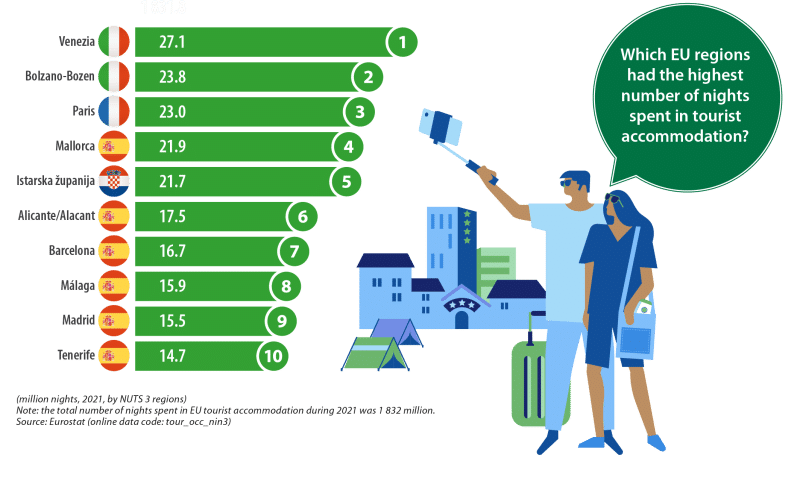Impact of Goverment Regulation on the Tourism Industry
The involvement of governments and their regulatory rhythms profoundly impacts the tourism industry and associated enterprises, including gastronomy, private lodgings, rentals, and more. Government regulations, or the lack thereof, can shape the entire landscape of tourism development, sustainability, and economic outcomes. This regulatory rhythms, dance -if you will- is going to have an impact on tourism growth. According to Eurostat, Mallorca is the fourth region in Europe with the highest number of nights spent in tourist accomodations.

The Regulatory Rhythms of Goverments Impact on Tourism Industry
Government regulations play a crucial role in defining the framework within which tourism operates. Regulations cover areas such as infrastructure development, environmental protection, safety standards, taxation, and licensing for tourism-related businesses. For instance, zoning regulations can determine where hotels or vacation rentals can operate, impacting local economies and urban development.
Economic Impact:
Government policies directly influence the economic viability of tourism enterprises. Tax incentives, subsidies, and infrastructure investments can spur tourism growth by attracting visitors and supporting local businesses. Conversely, excessive regulations or unpredictable policy changes may deter investment and hinder industry expansion.
Gastronomy and Local Businesses:
The gastronomy sector is closely intertwined with tourism, as visitors often seek authentic culinary experiences. Government support through culinary festivals, food safety regulations, and promotion of local cuisine can enhance tourism appeal and support small businesses. However, stringent regulations or lack of support may stifle innovation and competitiveness.
Private Lodgings and Rentals:
The rise of platforms like Airbnb has transformed the accommodation landscape, prompting governments to enact regulations to manage its impact on housing availability, neighborhood dynamics, and tourism revenue. Regulations range from licensing requirements to occupancy limits, aiming to balance the interests of residents, tourists, and property owners.
Sustainability and Environmental Considerations:
Government regulations are crucial in promoting sustainable tourism practices. Policies addressing waste management, wildlife conservation, and carbon emissions can mitigate tourism’s environmental footprint. In destinations prone to overtourism, regulations may limit visitor numbers or establish visitor quotas to protect fragile ecosystems.
Impact of Government Inaction:
Lack of government intervention or inadequate regulation can lead to negative consequences. Overtourism, environmental degradation, exploitation of local communities, and unfair competition among businesses are common issues exacerbated by insufficient oversight. Moreover, safety concerns and quality standards may be compromised without proper regulatory frameworks.
Case Studies and Examples:
Case Studies and Examples:
- Countries like Iceland and New Zealand have become renowned for their proactive tourism strategies, setting benchmarks in managing visitor influxes sustainably while preserving their natural resources and cultural heritage.
- In Iceland, for instance, the government has implemented measures such as visitor limits to popular attractions like the Blue Lagoon and the Golden Circle. These restrictions help maintain the integrity of these sites and prevent overcrowding, ensuring a better experience for tourists while protecting the environment.
- Similarly, New Zealand has focused on promoting sustainable tourism practices through initiatives like the Tiaki Promise, which encourages visitors to respect and protect the country’s natural and cultural treasures. The government and local communities collaborate on initiatives such as waste management programs and conservation efforts in national parks to mitigate the environmental impact of tourism.
In contrast, destinations struggling with unregulated tourism growth face significant challenges. Places like Venice and Barcelona have experienced issues such as overcrowding in historic city centers, strain on local infrastructure, and cultural erosion due to the influx of tourists. These cities grapple with balancing economic benefits from tourism with the preservation of their unique cultural identities and quality of life for residents.
The contrasting approaches highlight the importance of proactive governance and sustainable tourism planning. By adopting strategies that prioritize environmental sustainability, cultural preservation, and community well-being, destinations can effectively manage tourism growth while maximizing the benefits for both visitors and locals alike.
So, what’s the Next Step?
In conclusion, government involvement plays a pivotal role in shaping the tourism industry and its associated sectors. Effective regulations not only facilitate sustainable growth but also safeguard local interests and elevate visitor experiences. However, achieving a harmonious balance between economic development and environmental stewardship demands meticulous policymaking and collaborative efforts with stakeholders across various tourism-related industries.
Governments wield the authority to implement frameworks that promote responsible tourism practices, manage visitor influxes, and preserve natural and cultural assets. By establishing clear guidelines and incentives for sustainable development, they can mitigate the negative impacts of tourism on local communities and ecosystems while maximizing long-term benefits.
Furthermore, effective regulations foster an environment where tourism businesses operate ethically and responsibly. Measures such as zoning regulations, waste management protocols, and cultural heritage preservation laws ensure that tourism development aligns with community values and respects local traditions.
Nevertheless, achieving this balance requires continuous dialogue and cooperation among government bodies, tourism operators, local communities, environmental advocates, and other stakeholders. Collaborative efforts can lead to innovative solutions that address complex challenges like infrastructure development, resource allocation, and environmental conservation.
Ultimately, by adopting forward-thinking policies and embracing sustainable practices, governments can nurture a tourism industry that not only thrives economically but also contributes positively to cultural preservation, environmental stewardship, and community well-being. This approach not only enhances the quality of visitor experiences but also secures the long-term sustainability of tourism destinations worldwide.





